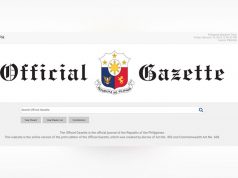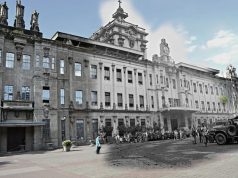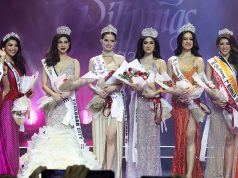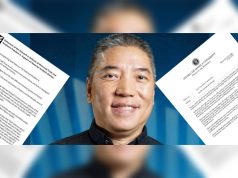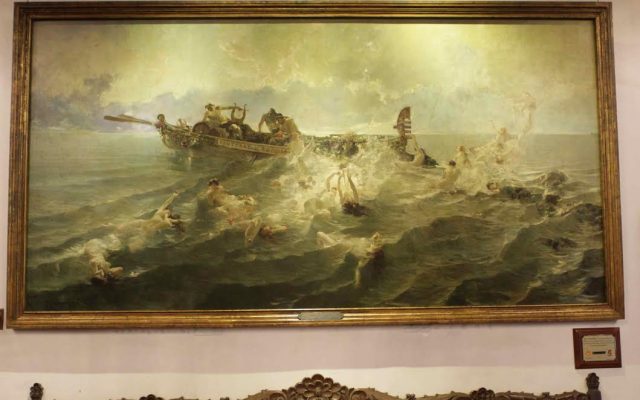
MANILA – Did you know that within the walls of the Presidential Museum and Library in Malacañang is a painting that is so valuable, if the Palace were to be destroyed, selling it would be enough to cover the entire restoration?
That painting is “Las Nereidas,” which was created in the 18th century by the great Spanish Impressionist Joaquin Sorolla y Bastida. It depicts a stormy Aegean Sea, a boat, and in the water surrounding it, a band of nude women.
A gift to President Elpidio Quirino by an American philanthropist, it is one of the gems of the collection, and would be the first item to be carried out should there be a catastrophe.
Netizens can now examine this painting right on their laptops, tablets, and mobile phones by going to g.co/pmlmalacanang, a collaboration between Google Arts and Culture and the Presidential Communications Operations Office (PCOO) which was launched on Wednesday at the Kalayaan Hall, which is home to the Presidential Museum and Library.
They can also download the mobile app, available for free on Android and iOS, by searching for “Malacañang Presidential Museum and Library.”
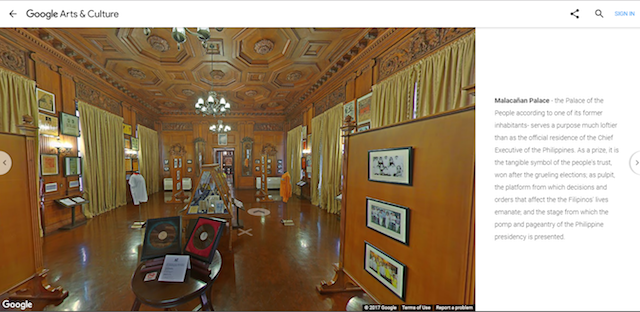
At least 70 artefacts are now accessible in the virtual museum, which has two exhibits: “Malacañang as Prize, Pulpit, and Stage,” and “Relics of Power: Remembering the Philippine Presidents.”
Part of the first exhibit is the chair President Ferdinand Marcos sat on when he announced the imposition of Martial Law on television in September 1972. According to the museum, it was also used by President Fidel V. Ramos during his term from 1992-1998. Interestingly, Ramos was Philippine Constabulary Chief and Armed Forces of the Philippines Vice Chief of Staff during Marcos’ time, but it was his, and then-defense minister Juan Ponce Enrile’s breakaway of President Marcos, that sparked the EDSA Revolution of 1986 and led to Marcos’ ouster.
The first exhibit also includes a yellow baby grand piano that was given by Yamaha to President Corazon Aquino in 1986.
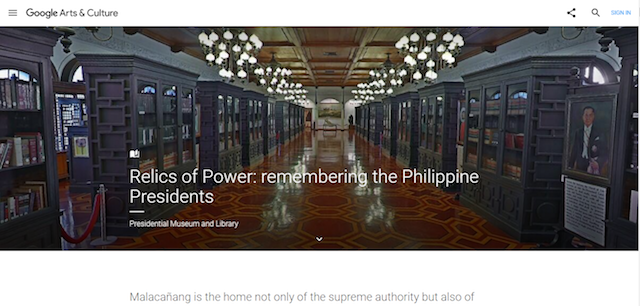
As for the second exhibit, there are full-body sculptures of Presidents Emilio Aguinaldo, Manuel L. Quezon, and Elpidio Quirino by artist Anastacio Caedo.
A copy of the proclamation of independence that Aguinaldo read on June 12, 1898 is also part of the collection. It bears his signature, dated August 1956.
There is also the chalkboard with a sketch of Camp Crame, which indicated the location of troops during the EDSA People Power Revolution in 1986.
Netizens can now go on a 360-degree tour of the Presidential Museum and Library and see all these, including memorabilia of President Rodrigo Duterte, such as his inaugural barong, his portrait done in mosaic-style and made of rice, and even a Halloween mask bearing his likeness.

Presidential Museum and Library Director Edgar Ryan Faustino said he was initially hesitant to commit to the project, as he feared visitors would no longer flock to the physical museum in Malacañang. The number of guests they receive fluctuates; sometimes they get 100 to 200 visitors a day due to school field trips.
But a change in perspective made him realize that the virtual museum could actually whet the public’s appetite for art, and could encourage them to travel to Manila to pay a visit.
“It’s just a teaser,” Faustino said. There was so much more to see at the actual site, and he now expected more people to visit them.
In fact, he added, they needed more tour guides to add to the seven that they now have.
Google Arts and Culture program manager Pierre Caessa, who is part of an engineering team based in Paris which initiated the innovation six years ago, also believes the Internet cannot evoke the same emotions that one gets when gazing at a work of art in person. The more artefacts are uploaded online, he said, the more the audience would be tempted to visit the actual museums.
He added that going online was a way to prepare for one’s trip to the museum. One would be able to better craft an itinerary, and enhance the visit, as well.
Sharing a nation’s story – Andanar
PCOO Secretary Martin Andanar looked forward to sharing the story of the naton with people “oceans and miles away.”
Whether in Africa or Antarctica, he said, they would be able to walk around the Presidential Museum and Library as long as they had the tools to do so.
He also stressed that it was a museum that “goes beyond personalities.”
For Kenneth Lingan, country manager of Google Philippines, the collaboration was a way to preserve culture and history for the generations to come. Overseas Filipinos could also show their kids treasures that could be found back home.
According to him, Google Arts and Culture had previously partnered with the Ayala Museum, Intramuros, and the University of the Philippines Visayas – Center for West Visayan Studies.
A press release reveals three more Filipino institutions: the Filipinas Heritage Library, the Filipino Street Art Project, and the Center for Art, New Ventures, and Sustainable Development (CANVAS).
Google Arts and Culture has partnered with 1,500 institutions worldwide. Six million artworks are now online, said Caessa.
He hoped that its partnership with the Philippines could be strengthened further, and looked forward to bringing more Filipino museums online.
Do you want to visit the Presidential Museum and Library?
E-mail [email protected] or [email protected] with the following information: preferred date and time of the tour; list of names and birth dates of all visitors; contact details of the group’s representative; and for foreign nationals, a photocopy of the main page of the passport.
You can also visit malacanang.gov.ph/reservations.




